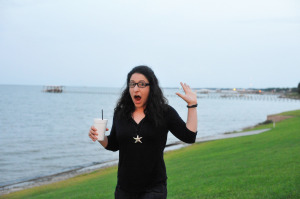by Sam Tackeff | Jan 8, 2011 | French Fridays, Lists
[First there was ‘Tuesdays With Dorie‘, where each week food-lovers across the internet united to bake a recipe from Dorie Greenspan’s ‘Baking: From My Home to Yours‘. And now Dorie is out with a wonderful new cookbook ‘Around My French Table‘ where she shares her favorite French recipes, and I’ve decided to cook along. Check out French Fridays with Dorie if you’d like to join the fun.
This week’s recipe is Dorie’s Paris Mushroom Soup (p.72), a warming soup for a cold winter day. The ingredients: butter, onions, garlic, mushrooms, rosemary, parsley, white wine (or sherry) and stock are minimal, but provide great depth of flavor. Instead of as suggested over a little salad of mushrooms and herbs, I added Rancho Gordo christmas limas to my soup, and a little swirl of Bariani olive oil. In accordance with ‘French Fridays With Dorie’ rules, I’m not posting the recipe – you must buy Dorie’s book to get the details. But believe me, it will be money well spent.]
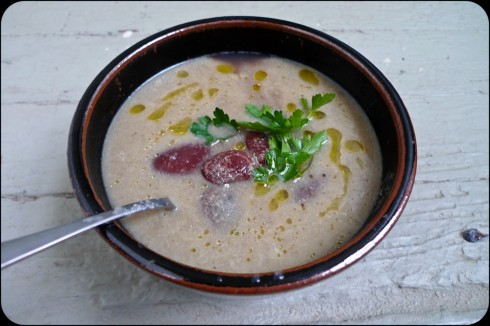
Gretchen Rubin, author of ‘The Happiness Project‘, asked in this week’s happiness challenge: “Are there little things in my life that I can do, that can make my life happier?” Rather than tackling massive problems, so much good can come out of making tiny changes, and keeping up with them regularly.
While I don’t write out specific resolutions each year, I do write lists for myself regularly, and find that I get more done by doing so. Lists make it easier to live purposefully. Instead of watching life pass me by, lists help me spring into action. Some of my lists are short, easily manageable tasks, others contain lofty goals for my lifetime.
I also like my lists to be flexible. Rather than write out resolutions, I chose a word of the year that can be applied to all aspects of my life. This year’s word is Habit. Habits are the little changes – the rituals – that help me do more.
This winter, my fascination with books has overtaken my fascination with food, for the moment at least. When I feel an inkling… I find it fulfilling to throw myself into things. I’ve been reading, and reading, and reading, so much that at times I think my head will explode. I’ve started a new 52 books project, which at this rate might become 150 books, although I suspect I’ll need to take a break now and then.
I’ve been making a bigger effort to journal, document and blog. I’ve found inspiration here about journaling. I’ve been attempting to take more photos and to take better photos.

After moving to San Francisco, I found myself forgetting rituals that I’d held dearly for years. There was something about the less pronounced seasonality perhaps – each season here is fleeting, blink, and it’s gone. So I started a list for that too. Here is my list for winter:
:: Winter To-Do List, 2011 ::
1. Make home-made Biscoff Spread.
2. Decorate the house with succulents and grass.
3. Winter dinner at Ad Hoc.
4. Work on my 2011 Happiness Project.
5. Bake parsnip fries. More than once.
6. Read! Write! 52 books project.
7. Make space for new books, dust book tops.
8. Flush drains with boiling water.
9. Clean out my closet, again.
10. Go through catalogs and magazines to recycle.
11. Drink hot chocolate. With marshmallows. (Home made, preferable).
12. Spelunking! (Antique shops – for vintage spoons and bowls, that is.)
13. Send Valentine’s day greetings a la Julia Child.
14. Plan a spring trip to a geologically significant area.
15. Continue X-Files Marathon. (Yes, I missed out when it was actually on TV.)
16. Broil a grapefruit with brown sugar.
17. Hunting! *For white ceramic animals.
What are your plans for this new year? Do you have things that you like to accomplish in the winter time?
by Sam Tackeff | Dec 11, 2010 | Baking, Books, Chocolate, Cookies

There are some cookbooks I read at the shop and fall madly in love with, but refuse to take home until I can no longer resist them because I know that I’m doomed when I do. Doomed! [Don’t worry, they win out at the end, I assure you.] Alice Medrich’s ‘Chewy Gooey Crispy Crunchy Melt-In-Your-Mouth Cookies‘ is one of those books.
This is because if there is any problem worse than my “cook-book problem”, it is my “cook-ie problem”. I am the type of person who will eat an entire batch of cookies if proper safeguarding precautions are not taken. And, as I’ve been giving in a little too often to my cookie problem, the one pair of jeans that I can still fit into are threatening to burst. I’m holding out as long as I can, damn it.
Alice came to Omnivore to talk about the book, and after spending a whole hour with the Goddess of Chocolate, it has taken every effort of mine not to bring it home and immediately start baking. My resolve was even further weakened by actually eating cookies made from the book:
For the talk, Celia made her Alfajores, a sweet and slightly crispy Latin American cookie filled generously with dulce de leche. Crispy and Gooey? Yes, please! She tweaked the recipe slightly to add some nuts and a little bit of extra salt. I had four, and would have had more had my mother not ingrained the principle of sharing. This was difficult. Had I been only a *slightly more selfish* and greedy person, there would have been none left in minutes.
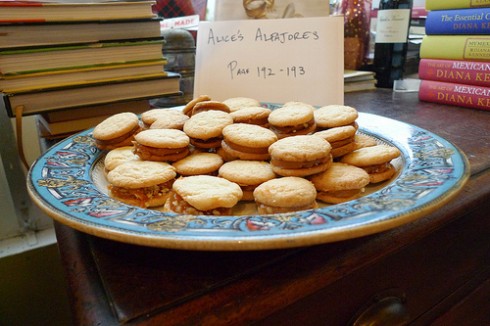
A few reasons why you need this book:
1. It’s by Alice Medrich. **(see below)
2. The broad organization. The book is a play on textures and flavors. You get to choose from Crispy, Crunchy, Chunky, Chewy, Gooey, Flaky, and Melt in your mouth. Alice Medrich is a “crispy” girl. I’m a “chunky” girl myself. Yes, I said that. The more chocolate hunks or nuts, the better.
3. It’s all in the details. “Cookies seem deceptively simple. But success with cookies is success in the details,” Alice noted. When you give the same recipe to ten cookie bakers, even experienced ones, you might just come out with ten completely different versions.
This book seeks to streamline your baking. If you can conquer at least some of the variables, you will make better cookies. A user’s guide, quick start, FAQ’s, ingredients, equipment, are all there to make cooking baking more precise and successful.
The quick start gives the five most important details about successful cooking baking: amounts of flour, types of flour, oven temperatures, preheating the oven, and types of baking sheets. The FAQ’s go into even more detail about basic ideas: how to toast nuts, why you would chill cookie dough, what the best way to flatten dough, etc.
And yes, Alice Medrich wants you to get a scale. (And so do I. I got mine at Ikea for 12 dollars. What are you waiting for?) The measurements in the book are also in cups, but using a scale will give you great, consistent results.
4. The “Smart Search”. Even better than just an index, there is a brilliant section called the “smart search”. Need Wheat-free cookies? She lists the 40 or so options for you. Whole-Grains? Dairy-free? Ditto. Ridiculously Quick and Easy? Same. Don’t have time to bake during the holiday season? Well, there’s a whole list of ‘Doughs that Freeze Well’ and ‘Cookies that Keep At Least 2 Weeks’. Yes, there are even low-fat. Although, I’ve become wise to understand that low-fat doesn’t in any way mean that you should eat the whole batch.
5. Simplicity. After 8 cookbooks, things are getting more do-able for the home-cook. That doesn’t mean that she skimped on the fun stuff. “Anything I do, I need to learn something, and I need to teach something,” Medrich says. There are classics, and new twists on old favorites. “I didn’t want it to be something that an ordinary home baker with kids wouldn’t want to pick up and bake from”.
6. Well tested recipes. If you are familiar with any of her older cookbooks, including her IACP winning book ‘BitterSweet‘ you know first hand that her recipes work. When she wrote her first cookbook, she did a huge series of ‘Side-by-Side’ testing in a kitchen with a friend to compare how they interpreted the written recipes, and tweak to get more consistent results. (A fairly genius idea.)
Medrich also teaches cooking classes. “The teaching helps, because I do the recipes and get to see what questions come up.” Teaching is also useful to help a recipe writer guide the reader in the recipes. Learning how people interpret words on the page teaches her to be a better writer and learn to use more specific explanations. And the difficult part of testing? “First, too much tasting, and second, knowing when to stop.”
7. Well written recipes. Often, recipes take for granted things that are intuitive if you’ve had a lot of practice in the kitchen, and the author forgets to write down steps that the novice might not yet know. When you read through any of Alice Medrich’s recipes, it’s like you have a perceptive friend guiding you through things, so you don’t forget the basics while under fire.
It was rumored that Julia Child once said to Flo Braker “Write what works for you, Dearie”, and Medrich re-emphasizes that. “The good writers are the ones who ignore how it’s always been done and explain it in a way that makes sense to them.”
8. The personal touch. Alice has been on the set since book one cooking and styling her own dishes for the photo shoots. (For those less familiar with cookbook production, this is rarely the case). “It’s the thrilling part of the process in this book!” she said.
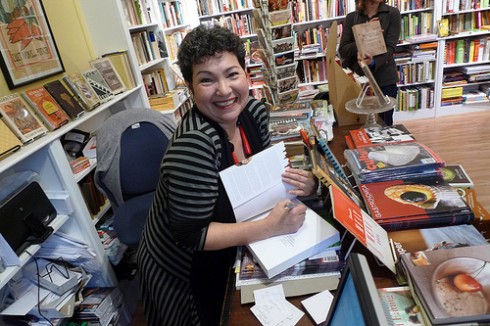
** While it’s important to focus on the merits of the cookbook itself, I take great pleasure in knowing the history of cookbook authors. It sweetens the deal when you get to use a book written by an inspirational (and smiling!) woman like Alice Medrich.
The Backstory:
When Alice Medrich was twenty, she went to Paris. It was there that Mme. Estelle, her land-lady, taught her about the Truffle, “that smooth, bittersweet statement about chocolate” that unbeknownst to her, would lead her to great things.
Upon coming back to Berkeley, her future still unclear, she opted for the rational lifestyle choice of putting off the real world… and heading to business school. Given that I almost went to business school right after graduating college, I can understand the impulse. (Though I’m glad I didn’t.)
At business school, she spent her free time making cocoa dusted chocolate truffles for the new Pig-By-The-Tail, Victoria Wise’s charcuterie shop. It didn’t take long to realize that she was becoming more interested in creating a dessert repertoire than dealing with case studies, and soon dropped out of b-school.
Before opening a pastry shop, Medrich did her due diligence. She headed back to Paris to take classes at Lenôtre, the famed pastry school, where she was often the only woman in her pastry classes.
She learned timing, temperature, and the physicality of multiplying recipes by trial-by-fire: at Pig-By-The-Tail, she would come up with a weekly special at the beginning of the week, an elaborate pastry that could be pre-ordered by six lucky customers. Without actually knowing if it would work, Medrich set about learning the recipes as she went – theoretically she would get enough practice by the end of the week to make at least six!
In 1976, she opened her shop, ‘Cocolat’.
I’ve heard more than one Bay Area native wax poetic about Cocolat and moan desperately about Alice’s legendary truffles. Celia (@omnivorebooks) used to head to the shop with cash from her co-workers in each pocket to pick up a bounty on her breaks. Mary (@mcs3000) recalled saving money to buy Alice’s first cookbook and making her Strawberry Carrousel Cake.
As a newcomer to San Francisco, it’s stories about shops like Cocolat that make me regret having not grown up here. By the time I moved here, Cocolat was no longer. (Pig-By-The-Tail, and Fran Gage’s Pâtisserie Française are others that I tragically missed out on.) I can’t live my life dwelling upon the fact that I’ve lived in the wrong era, but stories about the truffles and Cocolat’s ‘Reine de Saba’ make it hard not to. Another good reason for cookbooks like ‘Chewy Gooey” to help keep a legacy alive!
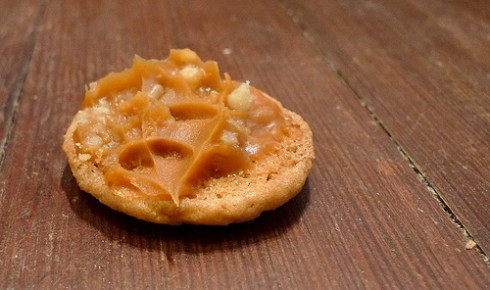
Alice’s Quick Bites:
That’s a lot of chocolate! In the early days, it wasn’t so easy to find quality ingredients. She used to send friends and family to purchase all the Ghiradelli Semisweet chocolate from the supermarkets (the best you could find at the time), until she realized that she used enough to get wholesale. Soon, Fifty pounds of chocolate wasn’t enough, and by the time she opened Cocolat, she was getting 300, even 500 pounds a month of chocolate delivered to her door!
Her favorite baking chocolates? “The most important thing is to use what you like the taste of. I still use Scharfenberger, because I like the taste a lot,” Alice says. (While I love using Valrhona myself, for chocolate chips I use Ghiradelli 60% cacao, which are flatter discs because of a higher fat content.)
Who eats all the recipes she tests? Her neighbors have been next door from her for more than thirty years, and they don’t accept treats anymore. (She fondly remembers the day that they sat down and ate an entire cake together.) Nowadays she gives them to whoever will take them – the new neighbors on the block, the synagogue down the street, a friend’s softball team.
On Inspiration: Inspiration comes from everywhere. Sometimes easily: “A lot of new recipes come from a recipe that is good already rather than a recipe you want to fix.” Other times, more abstractly: “I once developed a recipe from a salad from one of Paula Wolfert’s cookbooks.”
Her next project: Already in the works, a baking book for people more comfortable with cooking than with baking. Recipes that work the way cooks work, with a little bit more flexibility.
Chewy Gooey Crispy Crunchy Melt-in-Your-Mouth Cookies
by Alice Medrich
384 pages
Artisan Books
http://alicemedrich.blogspot.com/
by Sam Tackeff | Nov 13, 2010 | Baking
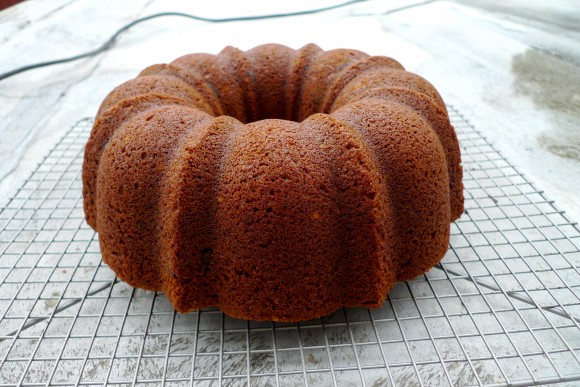
Each year when I put together my fall to-do list, there is one item always at the top: the Pumpkin Chocolate Chip Bundt Cake.
This bundt is the perfect cake for fall: moist, spiced, hearty and chock-full of chocolate chips. It’s the type of cake you want to eat at the end of a long day raking leaves or cleaning your closets. It’s also the kind of cake you want on a crisp Sunday morning, huddled with a steaming mug of coffee and a wrapped in a thick blanket.
Of all the recipes my mother makes, this one is my favorite. She found it in the Harrowsmith Cookbook v. 3, which she purchased for $17 from L.L. Bean on July 21st, 1988. Yes, she made a note of it.
The Harrowsmith Country Life magazine was a popular Canadian living magazine in the 1980s, which catered to hippie environmental homesteaders. They put out three excellent cookbooks, with recipes from editors, contributors, and readers alike. My mother has cooked out of this one on many occasions, always going back to the simple pumpkin bundt, everyone’s favorite.
When I moved to California, one of the first things that I bought for my own kitchen was this shiny bundt pan from Cookin’ on Divisadero, so that I could make the cake as soon as seasonally appropriate.
[Not that fall is necessarily the season – every year, my mother would ask me what type of birthday cake I would like her to make for me, and each year, the decision was brutal. Oreo ice cream cake with mint chocolate chip? Or a pumpkin bundt? Growing up in New England, either could be suitable for my May birthday – sometimes the thermometer read 90 degrees, other times there would be frost visible on the ground.]
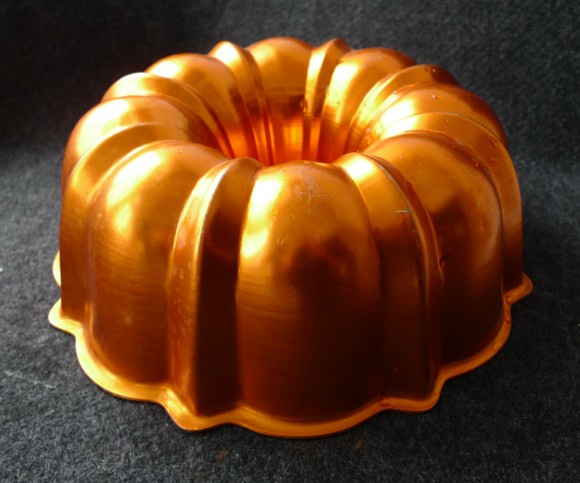
I’ve made this cake many times in my life, first at home with my mother, later as a teenager to take on hiking trips, or in college for the ladies of Dower House, my home at Wellesley for three years. Sometimes I’d make the full bundt, but more often than not, the batter became muffins, perfect to wrap in foil, and tuck in someone’s bag as a surprise. Muffins were also the practical fix, if, say, you ate too much of the batter to make a full bundt.
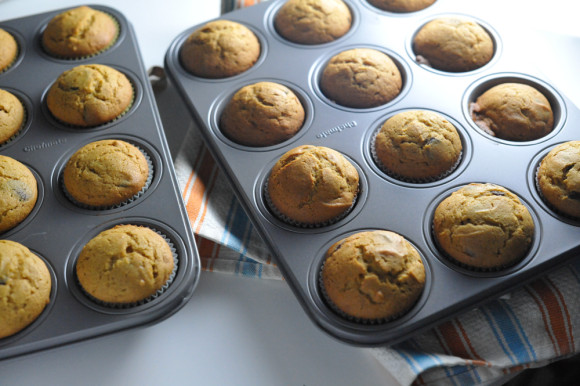
This year I started a new family tradition. I baked the cake, and sent half in the mail to my brother, John, a freshman at George Mason. He is living without a dorm kitchen, and was craving the Pumpkin Bundt as much as I was. Another good thing about this cake, is that it holds up fairly well in the mail for a few days.
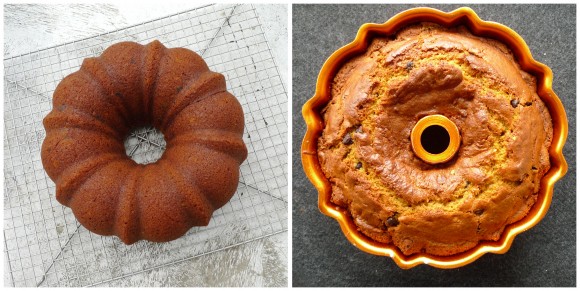
The recipe itself has just a handful of ingredients: flour, sugar, eggs, pumpkin, oil, baking soda, baking powder, cinnamon, salt, and chocolate chips.
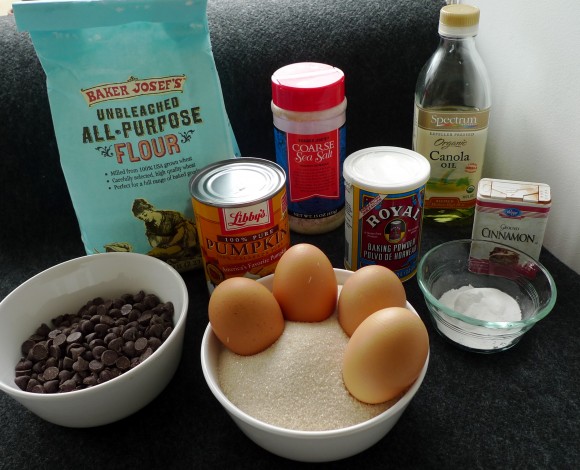
I set about preheating my oven to 350 degrees, and greasing and flouring my beautiful bundt pan. [This is key, otherwise your cake will stick to your bundt.]
The first step was sifting together all the dry ingredients in a bowl. Then, in a large bowl (or in my case, the bowl of Martha my KitchenAid mixer), I beat the eggs and sugar together.
Then, I added the oil and the pumpkin to the egg mixture, making sure to mix well. This takes a little bit of effort if you are stirring on your own, but it can be done!
I stirred the flour mixture into the wet mix, (on the slowest speed on the mixer to avoid a flour explosion), and lastly, folded in the copious amount of chocolate chips (and pecans, if you’d like them). I generally just use chocolate chips, because that’s what my mother does. (Mostly I believe, so that she could send this to school with me without worrying about children with nut allergies.)
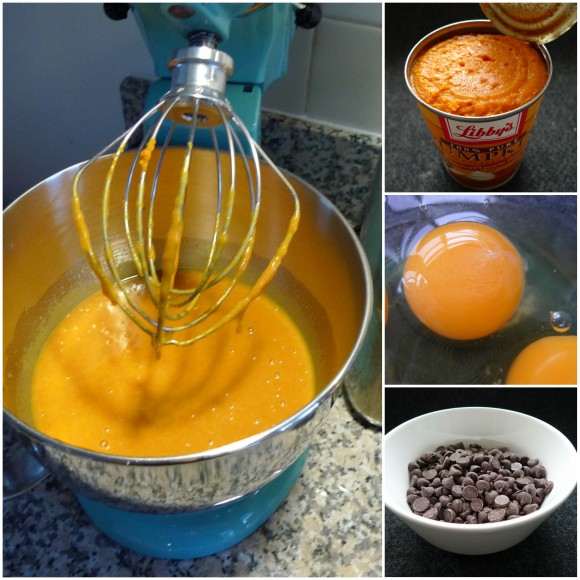
I poured it all into my bundt, (which I double-triple checked that I had greased and floured first!). The hardest part about this recipe is fighting yourself from eating all the batter.
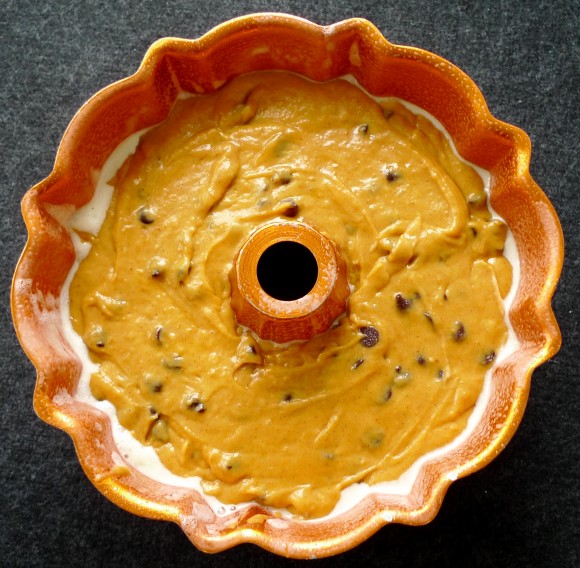
After an hour in the oven, I took the bundt out to cool for ten minutes in the pan before turning it out onto a rack. I listened to my mother’s voice in my head: “Just wait patiently!” This step is fairly crucial – waiting makes the difference between a bundt in one piece, and one that will fall apart.

Pumpkin Chocolate Chip Bundt Cake
The Harrowsmith Cookbook v. 3
The recipe comes from Gladys Sykes, of Regina, Saskatchewan.
While the recipe below can be done by hand, I do it in my kitchen aid mixer with much success. It also calls for sifting the dry ingredients twice, but one good sift will do. {Edited: A good many of you have asked if these can be made into muffins. They can indeed! I’d make sure to use liners, and reduce the time to 25 minutes, but you might check them at 18. If making muffins, this recipe will make two full muffin tins, and an additional mini loaf worth.}
3 cups flour
2 teaspoons baking soda
2 teaspoons baking powder
3 teaspoons cinnamon
1 teaspoon salt
4 eggs, beaten
2 cups sugar
1.25 cups canola oil
2 cups cooked, mashed pumpkin (or one 15 oz. can)
1 cup semi-sweet chocolate chips (or 1/2 cup chocolate chips and 1/2 cup chopped pecans)
Preheat oven to 350 degrees F, and butter and flour a bundt pan and set aside.
In a bowl, sift the dry ingredients (flour, baking soda, baking powder, cinnamon, and salt) together.
Beat the eggs and sugar together in a large bowl, or the bowl of your stand mixer. Add the oil and the pumpkin, mixing well, and blend in the flour mixture. Fold in the chocolate chips and pecans, if using.
Bake in the greased and floured bundt pan, for 60 minutes.
Let cool in pan for ten minutes, then turn out onto a cooling rack.

















